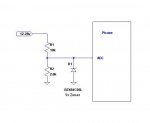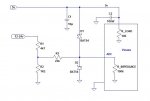Hi All,
I'm building a circuit that needs to be able to detect whether the incoming voltage is 12-14v or 24-28v DC. The detection is the easy part. Use a voltage divider and send the result to an ADC pin. Easy.
The part I'm concerned about is overvoltage. If for some reason more than about 28v gets sent down the line I need to be able to protect the ADC pin from getting blown. My thought is to use a zener 5.1v diode.
The schematic below provides an output voltage of around 5v at the voltage divider when a 24v source is applied. (about 2.2v when a 12 volt source is applied). So how do I size my zener and what size R1 do I need? I'm confused. I'm thinking that I need a 1 watt 5.1 Zener and a 45ohm 1 watt resistor at R1. Does this sound correct? Seems like I would be dissipating (wasting) a lot of energy through the resistor so these numbers don't sound right.
Keep in mind all I'm doing to sending a voltage to an ADC pin for reference.
I know this is probably basic electronics 101, but being a hobbyist, you learn what you need when you need it - and I've never needed this before. Any circuit I've ever used that had a zener in it was made by someone else. I just put it together. So sorry for such a basic question and thanks for any replies in advance!

I'm building a circuit that needs to be able to detect whether the incoming voltage is 12-14v or 24-28v DC. The detection is the easy part. Use a voltage divider and send the result to an ADC pin. Easy.
The part I'm concerned about is overvoltage. If for some reason more than about 28v gets sent down the line I need to be able to protect the ADC pin from getting blown. My thought is to use a zener 5.1v diode.
The schematic below provides an output voltage of around 5v at the voltage divider when a 24v source is applied. (about 2.2v when a 12 volt source is applied). So how do I size my zener and what size R1 do I need? I'm confused. I'm thinking that I need a 1 watt 5.1 Zener and a 45ohm 1 watt resistor at R1. Does this sound correct? Seems like I would be dissipating (wasting) a lot of energy through the resistor so these numbers don't sound right.
Keep in mind all I'm doing to sending a voltage to an ADC pin for reference.
I know this is probably basic electronics 101, but being a hobbyist, you learn what you need when you need it - and I've never needed this before. Any circuit I've ever used that had a zener in it was made by someone else. I just put it together. So sorry for such a basic question and thanks for any replies in advance!




